To me, my variants!
If you’re trying to decide “what’s the most famous example of variant comic covers of all time” — first, c’mon, what’re you doing with your life, and second, I think just through the sheer magnitude of copies that were unleashed upon an unsuspecting public, it’s gotta be 1991’s X-Men #1:
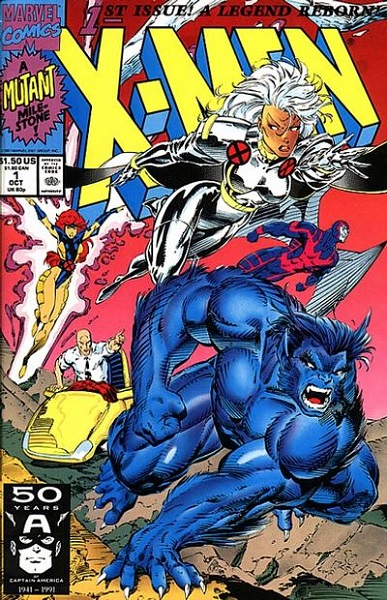
There were four different covers produced, the first three featuring a different mix of members of the team, with the final cover presenting their arch-nemesis Magneto. The four covers formed a single image when connected together, but if you didn’t trust your hand-eye coordination to assemble so complex a puzzle, Marvel had your back with the fifth variant: a gatefold cover that opened up to present the full image.
Unlike Spider-Man #1, the covers weren’t released all at once. Instead, Marvel decided to dominate comic sales for over a month by releasing each cover one per week, starting with the A, B, C and D covers (as they are usually referred to), culminating in the gatefold cover in the final week.
Orders were gargantuan. In total, over 8 million copies were produced, though as has been noted by multiple observers, and just through my own personal observation, a good chunk of those remained in retailers’ hands.
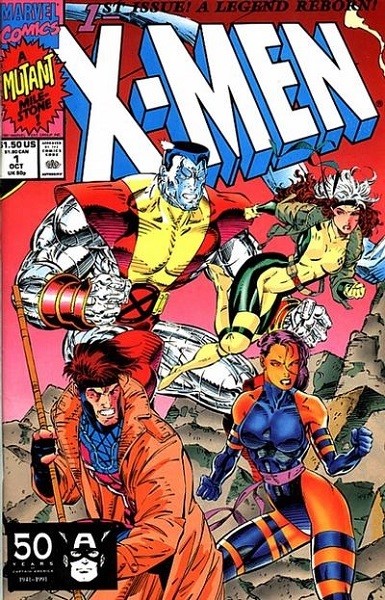
Speaking of personal observations, I’ve written in the past about how once impossibly-common comics from the ’90s marketplace are becoming slightly less easy to find in the wild, simply due to the attrition of stores that were active then having shut down in the intervening decades and taking their backstock with them. I’ve also written about how many of the people buying comics at the time either had no idea how to take care of their comics at the time (despite the wide variety of comic storage supplies being offered, and purchased, in sizeable amounts), or simply neglected their collections and let them fall to disuse and ruin over the years.
The point being…a comic that was once so commonplace and contemptuously familiar that copies were given away free with purchases is now, kinda sorta, becoming “collectible” again. Not to keep referring to things I’ve said in the past, but I’ve said in the past that even without actively buying copies of X-Men #1 in collections, I’m accumulating a backlog of it. And I’d say only abut a third of the copies I’ve seen have been in Near Mint or better, and when you actually have a copy in Near Mint (and not, say, VF- which you’re calling “Near Mint”) it can sell for a pretty good price nowadays.
Again, this all depends on local supply. There are probably still plenty of areas of High X-Men #1 Concentrations where they flow like water, and you merely need to dip your hand in a stream to retrieve a copy or three. And they’re all over eBay, natch. But, in areas populated primarily by newer stores, where even the bespectacled old men who have direct memories of those times and will gladly share them with you (ahem), they may not be as in deep a stock as they historically had been.
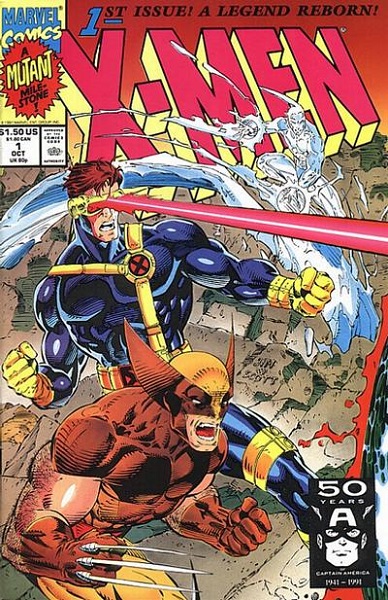
It was a large confluence of causes that resulting in this massive amount of orders:
- The ’90s were a boom time for collectible comics, with a huge influx of new customers driven to comic shops primarily by the 1989 Batman movie, with earlier successes like Dark Knight, Watchmen and Teenage Mutant Ninja Turtles helping to push the expanding market as well.
- It was the time of The Hot Artists, and Jim Lee may have been the hottest artist of the time. Launching an expansion of Marvel’s popular franchise with Lee on art chores couldn’t help but grab market attention.
- The investors were out in force. The aforementioned Teenage Mutant Ninja Turtles arguably kicked off a new wave of folks looking to make their fortune trading in “rare” comic books, and what could be rarer than eight million copies of X-Men #1? Okay, nobody knew it was going to sell that many copies, but it was a pretty easy guess that it was going to move some large numbers. That didn’t stop people from buying boatloads of copies in the hopes that they’d be able to turn them into houses or kids’ college funds down the road.
- This may be hard to imagine, but there was a time in comics publishing that when a new series was launched, the expectation was that the series would continue so long as sales held out, and maybe if sales dipped a little, the publisher would try things like “new directions” or “fresh creative teams” or more promotion to support the book. The idea that new #1s for titles would flash by like strobe lights was not one that was considered. As such, retailers would order plenty of first issues of titles, as that would likely be the most sought-after number in the back issue bins over the years, and hopefully decades, of the title’s life.
- And yes, the multiple covers. Outside of investors, just plain ol’ folk who bought comics and weren’t necessarily looking to turn a buck. As I brought up early on this ongoing series of “variant covers” posts, having different cover images was a way to encourage the regular reader to pick up more than one copy of a particular item. Plus, having the additional twist of making all the covers connect into a larger picture…it’s a cunningly evil plan that, I can tell you at least from my memories of selling the things at the time, worked quite well indeed.
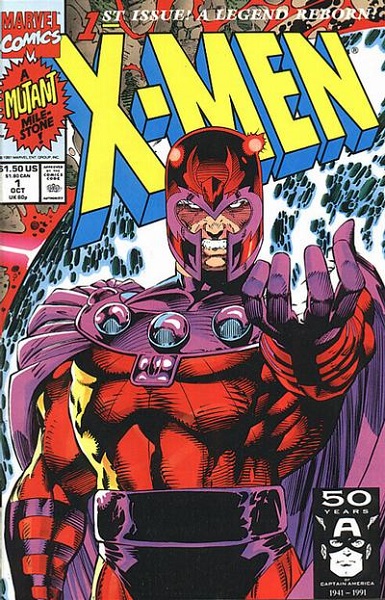
Some have pointed to this as being one of the causes of the ’90s market crash, and…I don’t know, I think there may be worse offenders (I won’t say any names, but the initials stand for Deathmate) since, all things considered, X-Men #1 actually sold (though again, not nearly as many as were ordered). There were bigger stinkers out there, at least to the point that X-Men wasn’t seen as a flop, whereas something like Turok: Dinosaur Hunter was. That said, I’m sure enough people got burned on their investments on ’90s comics, including X-Men #1, that they, and their money, fled the marketplace, reducing cash flow and feeding the crash.
So wither X-Men #1? It remains a popular seller, as do assorted issues from the 1991 series as a whole. There’s a whole new audience of comic book buyers and X-Men fans who weren’t around thirty years ago when this series launched. And there are plenty of customers who were around but misplaced, sold, or damaged their copies in the meantime and want replacements. And, of course, there’s the current wave of speculation mania driving sales on any “key” and/or first issues.
I don’t always have every cover in stock, but I usually have at least two or three different ones on hand. The cover I see the least? The gatefold cover. The one I see the most? Surprisingly, the fourth cover with Magneto, given that, according to this article, it was the poorest selling of the first four. And that gatefold cover was the highest selling. Huh, go figure. (Again, it all depends on how many copies actually got into people’s hands, and didn’t disappear with the retailers who ordered them.) It’s my memory that, as each cover was released every week, sales dropped a little with each one, with a boost on that final fold-out issue. But I could be wrong…it’s been 30 years, after all.
And which cover did I buy, since as a 1990s comics buyer you were legally required to buy at least one copy of X-Men #1? Why, the gatefold edition, of course…I wasn’t going to miss out on any of that artwork!
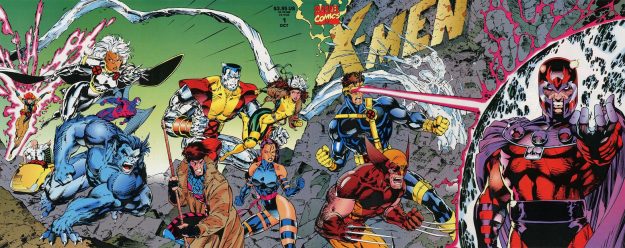
Next time in my variant cover-age, even though John kinda beat me to the punch: Robin comics! A whole lot of ’em! Holy gimmick covers, Batman!








I stopped buying “Uncanny X-Men” with issue 229* (I think; it was an issue plotted by Tom DeFalco) but I ended up buying this (Magneto cover) and the second and third issues all in one go, not based on the hype of a new X-Men series and potential $$$, but because they were the final Chris Claremont issues. I couldn’t believe he was no longer helming the series, even though I hadn’t read it in years at that point. Even seeing the “1975-1991” at the end of issue 3 drove home that he’d been writing X-Men stories since before I was born.
* I did buy issue 245 when it came out because between the hunchbacked Colossus trying to fit his head under the X-Men logo on the cover and the interior art, I couldn’t believe this was a professionally produced comic book. That was my introduction to Rob Liefeld.
Anecdotally, this was my stopping point with 90s comics. I saw this first arc of the book through, IIRC, and remember the story being mediocre… After being an enthusiastic X-men collector, I quit the book cold turkey, and then comics entirely soon after. I was 18, and the financial demands of concerts and having girlfriends probably would have had me quitting comics anyway, but, hey, I still place the blame on this puppy.
I’d like to hear your (retailer’s) perspective on ordering comics with all the rules for getting in various… variants. How has it changed the business for you when they started this system?
I stopped buying X-stuff after Inferno and didn’t go back until Morrison so I never bought this. But my recent nostalgia for Claremont X-men led me to buy all the X-men Omnibuses so I have the issue in that form.
The Hot Artists were completely lost on me. The previous several years of X-Men had had JRjr, Alan Davis, and Marc Silvestri drawing the heck out of the book. I get that Lee, Liefeld, and company drew dynamic motion, but so did those other folks… and they wouldn’t have drawn Magneto’s head way off-center with respect to his torso, or with such hypertrophy of the lats that his underarms looked like Falcon’s wings.
I own tens of thousands of comics, but not that X-men #1. I thumbed my nose at the “mandate” to buy it as I had stopped reading X-men by #200. But, boy did we sell the hell out of them at the shop. One thing, Mike, did you experience the customer rage when they found out about the gate-fold cover? It was almost torches and pitchforks in my neck of the woods. Probably about 80% of our X-men buyers flat out said that if they had known that was coming, they wouldn’t have purchased the others. I got a lot of dirty looks when I told them that was the whole point of them not knowing.
Re: Robin…I will continue to twirl my mustache as I extrapolate your next move.
Straying from the main point of variant covers into the ordering of new series…
Speaking of #1s, I remember back in the day, Wizard would be boosting the second issues of hot series by noting that stores would have ordered less than #1 but not yet had time to figure out what the ongoing demand was. In an era of relaunches, limited series not announced as limited series, and an emphasis on collecting series in TPBs or hardcovers, what’s changed about ordering second issues? Anything?
I was 13. God help me, I bought all 5 covers. We all did. We didn’t know any better. Some of us were even worried some of the covers would sell out! To own three copies of X-Men 1 and was unthinkable.
I loved this comic, and read it over and over. Every character got a cool moment and a splash panel! The Gold Team showed up for a Danger Room sequence! The X-Men vs. Magneto! All drawn by Jim Lee, getting the best coloring and paper stock of his career to that point! Also, a whole lot of words!
X-Men 1 might be overwritten, under plotted, and a harbinger of worse comics to come, but it was a big hit with the under-18 crowd. I still have a fondness for it, to the point that I had my cover E signed by Lee & Claremont. It was the Biggest Event in Comics, at least until the Image revolution and the death of some guy in blue tights.
Here’s my controversial opinion- why didn’t Marvel KEEP doing this?
Hear me out. I’m not saying every month. But imagine if, once a year, Marvel put out a book with this level of push- a BIG gatefold cover book and variants, a number one that kicked off a new story easy for new readers but rewards long-time fans, and the promise of the start of new adventures.
Marvel (and everyone else) got the wrong message from X-Men 1. Readers didn’t want a new #1 every month- they wanted a special book every once in a while, and if it was good, they’d stick around. (And stupidly, they fired Chris Claremont from the book two issues later, and Jim Lee was gone 9 months or so after that, and the stories were a mess, and there it all went.)
It’s the same thing with the Death of Superman. Yes, a lot of the audience wanted the “Death” issue…but DC mismarketed Adventures of Supes 500 as the “Return” issue, rather than the start of the four replacements. Had there been a little more truth in advertising, that story- which was still really good and deserved better- would have been better received and properly ordered by stores, and not the commercial disaster it was.
As I recall, you could occasionally find X-Men #1 in dollar/quarter/dime boxes for a while…but you could find whole boxes of Adventures of Superman #500 for YEARS. It’s those thing- the boxes of Turok, the boxes of Deathmates, the late books that tied up money, and the inability of the Big Two to use this rare opportunity to build new audiences that caused the big crash.
The funny thing is how *well* the Direct Market did in processing those X-Men books. There are very few businesses that can handle 8 million of anything in a short period of time. Those X-Men books were released one a week over a month, as I recall. To completely sell 8 million books in a 30 day span, the DM would have to sell 3 copies every *second*. That’s insane! In an industry that barely had cash registers! With no e-commerce to speak of! And they still sold a bunch!
At some point, we’re going to realize that as much as we look at the crash of the 90s as a failure, there were a ton of lessons that should have been learned that could have helped the retailers and publishers that came after to grow their business. Instead, the only real lesson that was learned was to cut orders to the bone, which led to the current market we have today. And that makes me sad.
It’s a self-defeating market. The reason that so many people were buying comic book was due to knowledge that comics like Action Comics #1 or X-Men #1 (1963) had increased in value so greatly over the years.
Speculators were convinced that comics were the new gold. They bought multiple copies of comics that they expected to get “hot”, and never bothered to read them.
They put them in their closet and waited for the day that X-Force #1 was going to be worth $10,000 so they could sell it and retire early.
They missed some key points.
No one expected that X-Men #1 (1963) was ever going to be worth money. Action Comics #1, many copies of it were destroyed as part of the paper drive during WW2. Many more copies were destroyed because kids were buying a cheap, disposable entertainment. They read it and tore it up, or their parents threw it away when the kid was done reading it and left it laying on the living room floor.
A comic series that everyone expected was going to be worth a fortune and that comic companies were pumping out to fulfill expected demand is never going to end up the priceless commodity as something published in 1939.
Speculators eventually figured out that all these copies of “Death of Superman” or Spider Man #1 were never going to be worth thousands and thousands of dollars and they were wasting their money.
So, they dropped out of collecting comics.
Most retailers have to cut their orders as much as possible now, because comic book stores simply struggle to make a profit (unless it’s a mega-store like Mile High Comics).
They can’t afford to lose money. Every copy of a random comic they purchase which sits on a shelf for months is lost profit.
The store I frequent, the guy retired from General Motors and that’s the only reason he can continue to stay open.
He has made a profit on only very infrequent years since the start of the 2000s. Most years, he breaks even. He says that as long as he’s not losing money, he’ll keep the store, but he says that it’s rare when at the end of the year he’ll have made any profit at the store.
It’s not like it was in the early-1990s.
There were so many “fly-by-night” comic stores. Every small town around me had a comic book store opening.
As soon as the market crashed, all but four of those stores went out of business.
As the years have gone by, two more of those stores eventually folded.
One of the two remaining stores has gone through the hands of multiple owners since 2008. Otherwise, it would have closed also.
Going by what Mark Laughlin said about being 13, this was the tipping point for our store losing a few older customers (my age, 30-33), some dropping a lot of Marvel, certainly the X-Men titles.
What kept us in business were the younger kids and the new speculators. One guy who was high up in the Lettuce Entertainment restaurant chain would spend $150 every other week, wanting 5 of every #1, even Impact! comics. On Sundays, the only money we made was from the Mortal Kombat game, but one guy picked up his books once a month, he even bought those weird rock ‘n roll comics that alternated with celebrity issues, and would drop $60. Needless to say, comics were 75 cents each, right?
So maybe four guys paid the rent for the month, and we had young kids going through the back issue bins thinking an X-MEN comic from six months previous was a great buy.
Then came Image in general. I still think part of the reasoning behind the new52 was that someone though that those 15 year olds from the early 90s were then 35 in the early 10s, and they had more disposable money.
Mike: I hope you will bring up the mysterious 5th color that Marvel advertised. Turned out to be Chromium, which just made Galactus more purple.
This comic brought me back to the X-Men after some time away. I wasn’t a big fan of the Outback era or Marc Silvestri, so I dropped Uncanny X-Men after years of collecting it religiously. Jim Lee and the promise of a fresh start at the mansion brought me back.
I lasted a few issues and then dropped this again as the writing became…less compelling. Claremont wasn’t at the top of his game at this point, but he was still better than what came after. And I’m glad I stopped when I did because the “new direction” obviously fell apart pretty quickly.
For the record, I got the first cover (didn’t want to wait even a day to read it) and the gatefold (because that one was super cool). I totally forgot I bought two copies of this one, so I lied on your previous poll about variants. Your data has been compromised! ;)
Bryan: “245”
And that’s not even the worst Liefeild! But it does look silly.
[…] you’re not wrong. It’s like Robin II somehow managed to take the multiple covers of X-Men #1 and the polybagged editions of Spider-Man #1 and formed them into this unholy collectible amalgam. […]